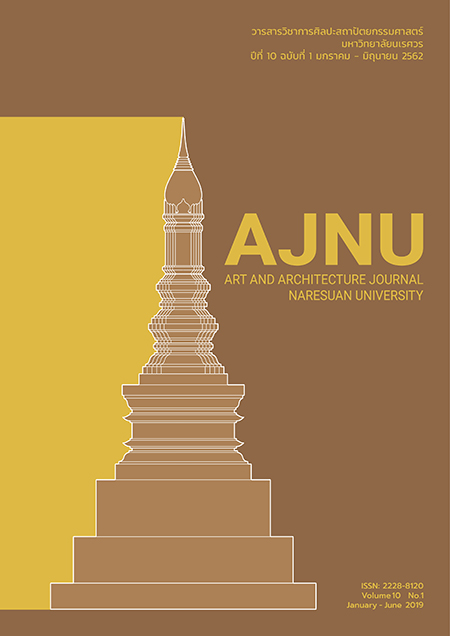FURNITURE DESIGN CONVEYING CORPORATE STRATEGIC IDENTITY AND RESPOND TO FUNCTIONAL NEEDS: A CASE STUDY OF K BANK
Main Article Content
Abstract
This is a study. Design of furniture that reflects corporate identity and responsiveness to service delivery strategies: a case study of KASIKORNBANK. purpose To study the factors and processes of furniture design that characterize corporate identity and respond to the strategy of use. For use in corporate standard furniture design. And to propose furniture design guidelines that can convey the attributes and identity of the organization. And respond to the strategy of use. Kasikorn Bank branch is a case study. By analyzing the factors and processes of interior furniture design, it is possible to optimize the company's clarity and unique identity as well as improve the usability of furniture. In this study, there are 5 theoretical concepts which correspond to the strategy. Companies like customer behavior theory, knowledge theory, and environmental insights. A structured questionnaire was used to ask for understanding. By analyzing environmental issues in corporate identity and corporate strategy, the two issues were compared. It was found that the factors of organizational identity and organizational strategy were similar when the average values were similar. Demonstrate the correlation coefficient. (Correlation) in each design factor. Show that corporate identity media and corporate media strategy. Can be the same or representative of each other.
Therefore, in this research, corporate identity can convey the corporate strategy and to align with the target group's perceived service as KASIKORNBANK
Article Details
References
กลยุทธ์การให้บริการของธนาคารกสิกรไทย .[ออนไลน์]. เข้าถึงได้จาก www.kasikornbank.comข้อมูลธนาคารกสิกรไทย . [ออนไลน์]. เข้าถึงได้จาก www.kasikornbank.com
ชนิดา ภู่อุดมศักดิ์. (2551).การศึกษาเกณฑ์การออกแบบเอกลักษณ์เชิงพื้นที่เพื่อการใช้สอยและรูปแบบสภาพแวดล้อมร้านค้า
แบบเฟรนไชส์: กรณีศึกษาร้านไอศครีมสเวนเซ่นส์. ปริญญาศิลปศาสตรมหาบัณฑิต, บัณฑิตวิทยาลัย,มหาวิทยาลัย
กรุงเทพธงชัย สันติวงศ์. (2533). พฤติกรรมผู้บริโภคทางการตลาด, พิมพ์ครั้งที่ 5, กรุงเทพมหานคร: ไทยวัฒนาพานิชย์
นวลน้อย บุญวงค์. (2539). หลักการออกแบบ.กรุงเทพมหานคร: จุฬาลงกรณ์มหาวิทยาลัย
พฤติกรรมผู้บริโภค. [ออนไลน์]. เข้าถึงได้จาก https://www.rilp.ac.th/webpage_tec/sunisa/download/ebook/doc. (วันที่ค้นข้อมูล: 16 ธันวาคม 2546)
วรรณี สหสมโชค. (2549). ออกแบบเฟอร์นิเจอร์. กรุงเทพมหานคร: สมาคมส่งเสริมเทคโนโลยี (ไทย-ญี่ปุ่น).
วิมลสิทธิ์ หรยางกูร. (2541). พฤติกรรมมนุษย์กับสภาพแวดล้อม,พิมพ์ครั้งที่ 5 (กรุงเทพมหานคร : สำนักพิมพ์แห่งจุฬาลงกรณ์ มหาวิทยาลัย.
สาคร คันธโชติ. (2528). ออกแบบเครื่องเรือน .กรุงเทพมหานคร: โอเดียนสโตส์.
ศรีดารา ติเพียร. (2551). กระบวนการวิจัยเชิงประจักษ์สู่เกณฑ์การออกแบบห้องพักผู้ป่วยเดี่ยวของ
โรงพยาบาลในบริบทพฤติกรรมและการรับรู้ของไทย. วิทยานิพนธ์ สถาปัตยกรรมศาสตรมหาบัณฑิต (สาขาวิชา สถาปัตยกรรมภายใน). กรุงเทพฯ : บัณฑิตวิทยาลัย สถาบันเทคโนโลยีพระจอมเกล้าเจ้าคุณทหารลาดกระบัง
อวิรุทธิ์ เจริญทรัพ และ นฤพนธ์ ไชยยศ. (2547). จิตวิทยาสถาปัตยกรรม (กรุงเทพมหานคร : สำนักพิมพ์ ศูนย์สนับสนุนและ พัฒนาการสอน มหาวิทยาลัยรังสิต.
Sumner, M. (1990). Computer: Concept and uses. 2nd ed. New York: McGraw-Hill.
Jackson, M.H. Stewart, D. and Steven, G. (1991). Environmental Health Reference Book. Oxford:
Butterworth Heineman.

